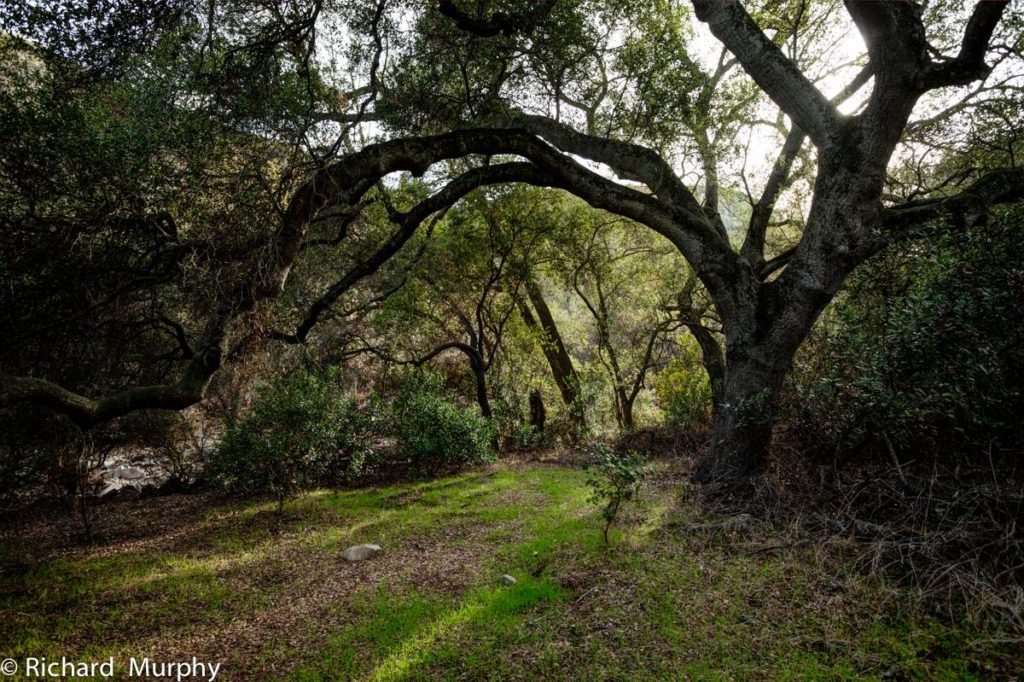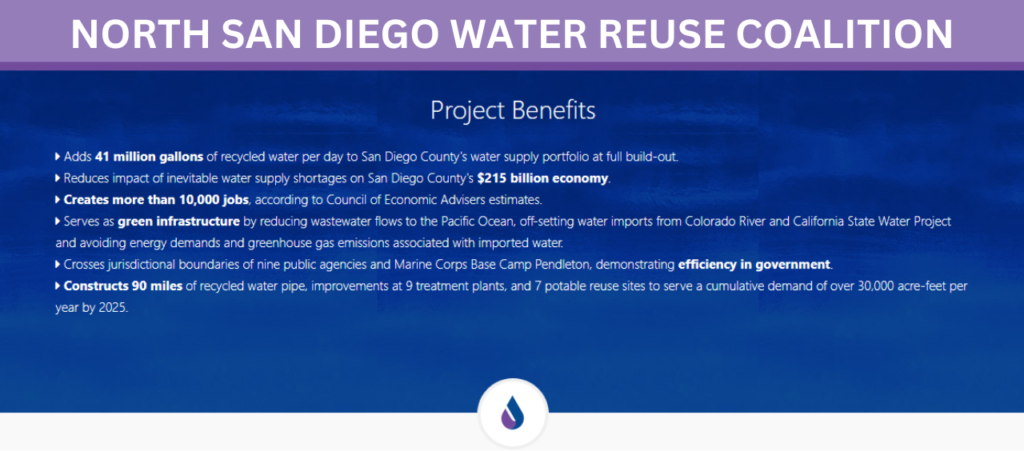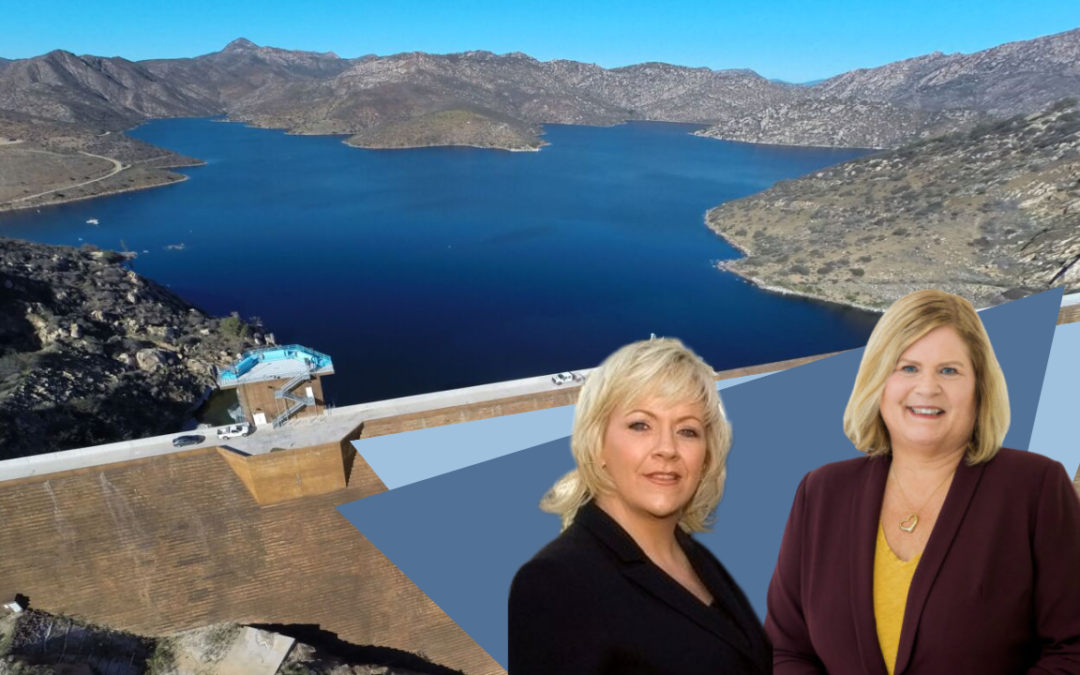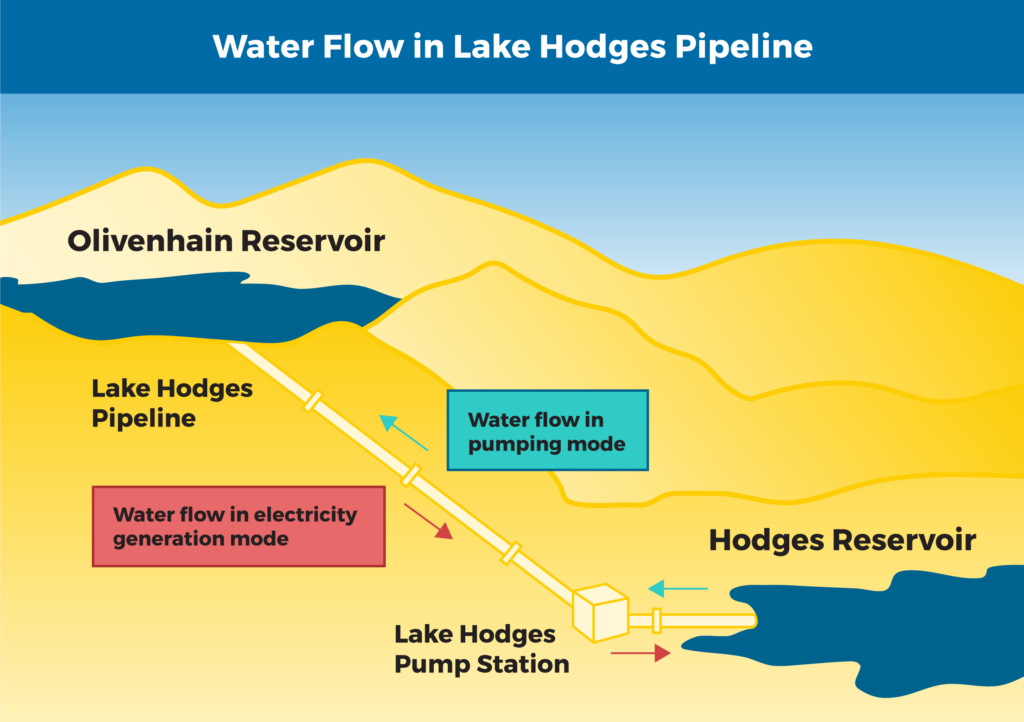“What comes out of the tap today has been in planning for the last 20 years.” This quote has been ringing in my ears every time I turn on the faucet since my interview with Kimberly Thorner and Sandra Kerl, General Managers for the Olivenhain Municipal Water District and the San Diego County Water Authority.
What goes into making water come out of the faucet? “A lot of people think, ‘Water falls from the sky. Therefore, you guys store it, you treat it, and it comes.’ They don’t realize what actually goes into what comes out of the tap. It’s the same misconception that I kind of had in the beginning (of this job),” said Thorner.
Common Water Misconceptions & Questions
- Misconception: A couple of rainy days will solve the problem. Fact: Long dry spells in between rain can outweigh the benefits of a few rainy days. “It’s not particularly useful to talk about the ‘last drought’ or the ‘current drought,’” said Kerl. “Since 2014, we’ve only had a few wet years, and [our region is] getting hotter, drier, and heading toward aerification of the West. We have drier conditions than we’ve ever seen before, and that is expected to continue.”
- Misconception: We need rain, we need it here, and we need it now. Fact: It matters where and even when it rains. “People get excited if it rains in San Diego County, but it hits, and then it goes,” said Thorner. “If it snows in the Sierras or Colorado, we’re more excited about that. But we’re even down to the timing of WHEN it snows. If it snows too early and gets warm, you don’t get the Spring melt runoff.”
- Question: Where can I focus my water conservation efforts? Answer: 68 percent of water is used outdoors. Fixing leaks and adjusting landscape can make a huge difference. “Taking your irrigation down to 2-3 days a week is such a big impact,” said Thorner. “Take advantage of the free water use efficiency evaluations (sponsored by the Water Authority). Someone comes out and gives you minor tweaks and adjustments. It’s a fantastic tool to reduce your water use and still have the landscaping that you want.”
- Question: How much water do we actually conserve as a region? Answer: San Diego County has reduced its per capita water consumption by 40% since 1990. That amounts to a reduction from 235 gallons per person per day in 1990 to 126 gallons per person per day in 2022. Countywide, over 16,000 homes and businesses have used WaterSmart Checkups to make sure they are using water efficiently, and 42 million acre-feet of grass has been removed in the region using rebates. “We’re very appreciative of what [customers have] done so far in conversation and supporting the investments regionally,” said Kerl. “We’ve made great progress in conservation. We’re continuing to ask folks to do more. That’s part of the whole picture of becoming water resilient.”
What does the San Diego Water Authority Do?
“As a water wholesaler, the San Diego County Water Authority is ultimately responsible for ensuring there is sufficient water supply to serve the region with 3.3 million residents and a $24 billion economy,” said Kerl.
The Water Authority secures and delivers water to its 24 member agencies who then sell it to residential, commercial, and agricultural customers. They also maintain 310 miles of large-diameter pipes, own and operate a dam and a water treatment facility, partner in a public/private desalination plant, and advocate at the state and federal levels for investments in San Diego County water infrastructure.
“There needs to be increased investment (in water infrastructure) and San Diego is a great place to do that because of our track record of delivering on projects outside of the region and our ongoing need,” said Kerl.
Water & Electricity
If that were not enough, the Water Authority looks for opportunities to create hydroelectricity with the water supply to support the energy grid. They own and operate the Lake Hodges hydroelectric facility, and they create in-line hydroelectricity at Rancho Peñasquitos, by using the pipeline pressure to generate power. Their biggest current energy project is a partnership with the City of San Diego to build a 500-megawatt energy storage project at the San Vicente Reservoir.
“San Diego has the most rooftop solar in the state of California. To be able to utilize that effectively when the sun goes down, you need to be able to store that power for high demand periods,” said Kerl. “Doing this project will help stabilize the grid and reduce the chance of rolling blackouts.”
Projects like this also help reduce the cost of water for ratepayers by monetizing infrastructure investments.
“The San Vicente energy storage project, if it moves forward, will create a venue stream for the city and for the Water Authority to reduce the cost of water. We’re looking for those opportunities wherever they exist,” said Kerl.
What does a “Member Agency” do?
As one of the Water Authorities’ member agencies, Olivenhain Municipal Water District, serves about 86,00 residents from San Diego, Solana Beach, Carlsbad, and Encinitas. They supply water to customers, create hydroelectricity, treat wastewater, create recycled water, and even have their hand in parks and recreation.
After receiving the Elfin Forest Recreation Reserve land for one dollar from the Bureau of Land Management, OMWD received permission to build a reservoir there on the condition that they also operate it as an open space recreational reserve.

Eflin Forest Recreational Reserve operated by Olivenhain Municipal Water District
Diversification of the Water Supply
Prior planning is truly the way to prevent poor performance when it comes to the region’s water supply. One of the ways the Water Authority plans is by diversifying its supply portfolio. While the Colorado River is a main water source, the Water Authority and its 24 member agencies have developed potable water reuse and desalination projects.
“For [OMWD], we used to be 100% potable water. Now 15% of our supply is recycled water. Golf courses, HOA common areas, parks, and medians now use recycled water,” said Thorner. “We’re also studying the feasibility of a brackish desalinization plant within our service area and utilizing automated meters (AMI) that connect to towers so customers can get instantaneous water use information.”
Colorado River Supply
The Water Authority has also invested in infrastructure to support the water supply. This is part of the reason that California, and San Diego County, have high-priority rights on the Colorado River water.
“Our water out of the river was secured both through conservation practices as well as lining two earthen canals. The saved seepage conserved water that was transferred to San Diego over long-term agreements,” said Kerl. This means that the government-mandated demand cuts don’t apply to California or San Diego County (yet), but the Water Authority continues to diversify the region’s supply.
“We’re looking for ways to support others who depend on the river to reduce their take,” said Kerl. “The situation on the river is very challenging, but through what we’ve done in new investments, supplies, and conservation, we’ve been supporting actions for the river to be healthy for a long time.”
Challenges of the Water Industry
North County is facing many of the same challenges that we’re seeing on a national and global scale. Kerl and Thorner agreed that one of their biggest challenges is balancing affordability for customers while supply chain issues create rising costs for them as suppliers.
“Change is happening globally, nationally, regionally, and locally, every minute of every day, and it impacts our ability to provide water,” said Kerl. “The pandemic, civil tension, the inflation – it is just a ball of stuff that never stops, and we’re always trying to put our A-Game forward to keep up with it.”
“Water doesn’t have a downtime. Water is life, and you have to supply it. Balancing the challenges of the world that everyone is facing, and maintaining the water supply reliability and delivery is a daily battle,” said Thorner.
North San Diego Water Reuse Coalition
Since 2012, nine cities, water agencies, and wastewater agencies have partnered to form the North San Diego Water Reuse Coalition. Their goal is to expand recycled and potable reuse water throughout San Diego County. Each of them have a water recycling project, some with wastewater plants, some with recycled water needs.
They meet monthly to discuss how they can enhance the use of recycled water without regard to jurisdictional boundaries. Recently, they were awarded $24 million in federal funding to enhance potable water reuse throughout the region.

The Buck Stops with You
Both Thorner and Kerl have been located in San Diego County for most of their professional careers. Thorner became the General Manger of OMWD in 1996. A lawyer by training, she received two job offers: one, to build the Olivenhain Water storage project, and two, to work for the general counsel. When asked which one “felt better” to her, she chose the water job.
“The part that I love (about my job is) every single day there is something different. As general manager, the buck stops with you to make sure the safe reliable water supply makes it to the residents,” said Thorner.
Thorner loves the diversity of North County, the ability to go surfing in the morning and hiking in the mountains in the afternoon. “People come here to play, and it’s where we live. Why would you go anywhere else?”
No Higher Mission
Kerl became the General Manager of the Water Authority in 2009 after working as the city manager of La Mesa. After meeting her predecessor, Maureen Stapleton, she became fascinated with the field.
“There are a lot of things you can live without, and water is not one of them. To be responsible for delivering a critical, life-affirming service… there’s really no higher mission to me,” said Kerl.
Kerl grew up in an agricultural community, and so the agricultural industry in North County appeals to her. She takes a lot of pride in the Water Authority’s programs to sustain farming in the region, both because of its economic impact and the quality of life that it provides.
“There’s really no finer corner of the country in my view,” said Kerl. “Part of it is the diversity of the economic base – from biotech, to manufacturing, to farming – and part of it is all the natural assets here.”
Read the story covering Max Villalobos, COO for Kaiser Permanente North County Project here for more content.
Get to know some of North County’s entrepreneurs, innovators, and leaders, and learn why they believe this region is a world-class place to do business. If you would like your company featured in “Meet North County Stewards,” or if you’d like to nominate someone for an interview, click this link to submit your nomination!
About the Author

Caitlyn Canby loves to discover and share people’s stories. She has her bachelor’s degree in Communications, Print Journalism with over 8 years of journalism experience. An Escondido native, she just moved back from Catalina Island to North County with her husband and two children to the town of Fallbrook. Caitlyn enjoys collaborating on projects as Marketing and Events Coordinator at SDNEDC, traveling, and exploring new restaurants, venues, experiences, and cultures.


